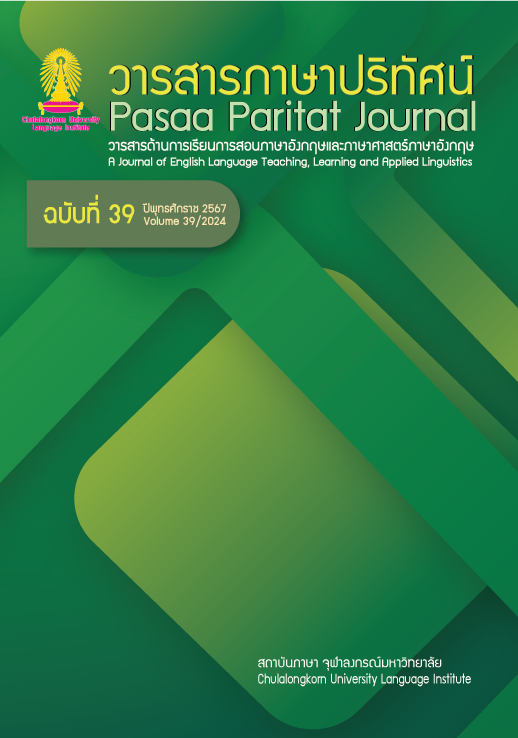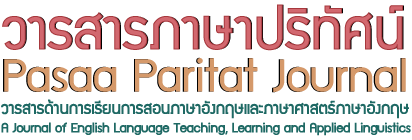การสืบสอบบทบาทของกริท (Grit) และความเต็มใจในการสื่อสารภาษาอังกฤษของนักศึกษาระดับบัณฑิตศึกษาชาวจีน ในบริบทวิชาการที่ใช้ภาษาอังกฤษเป็นสื่อในการสอน
คำสำคัญ:
นักศึกษาระดับบัณฑิตศึกษาชาวจีน, บริบทวิชาการที่ใช้ภาษาอังกฤษเป็นสื่อในการสอน, กริท, ความเต็มใจในการสื่อสารเป็นภาษาอังกฤษบทคัดย่อ
การศึกษานี้มุ่งสืบสอบกริทและความเต็มใจในการสื่อสารเป็นภาษาอังกฤษในบริบทวิชาการที่ใช้ภาษาอังกฤษเป็นสื่อในการสอน โดยใช้การวิจัยในรูปแบบผสานวิธี ในการเชื่อมโยงข้อมูลเชิงปริมาณ (ที่ใช้แบบสอบถาม) และข้อมูลเชิงคุณภาพ (ที่มีฐานจากการสัมภาษณ์กึ่งโครงสร้าง) เพื่อตอบวัตถุประสงค์วิจัย 3 ข้อ ได้แก่ 1) เพื่อตรวจสอบระดับของกริท และความเต็มใจในการสื่อสารเป็นภาษาอังกฤษของนักศึกษาระดับบัณฑิตศึกษาชาวจีนในบริบทวิชาการที่ใช้ภาษาอังกฤษเป็นสื่อในการสอน 2) เพื่อศึกษาความสัมพันธ์ระหว่างกริท และความเต็มใจในการสื่อสารเป็นภาษาอังกฤษของนักศึกษาระดับบัณฑิตศึกษาชาวจีนในบริบทวิชาการที่ใช้ภาษาอังกฤษเป็นสื่อในการสอน 3) เพื่อตรวจสอบว่าผู้เรียนที่มีระดับกริทสูงจะยังคงรักษาระดับความสนใจในการใช้ภาษาอังกฤษในบริบทการใช้ภาษาอังกฤษเป็นสื่อในการสอนได้หรือไม่ นักศึกษาระดับบัณฑิตศึกษาชาวจีนจำนวน 66 คนที่กำลังศึกษาในหลักสูตรการศึกษาสองระบบภาษาในบริบทวิชาการที่ใช้ภาษาอังกฤษเป็นสื่อในการสอนได้รับการคัดเลือกแบบสุ่มให้เป็นผู้ตอบแบบสอบถาม นักศึกษาที่มีระดับกริทสูงจำนวน 9 คน ได้รับการคัดเลือกโดยสมัครใจจากนักศึกษาจำนวน 66 คนให้เข้าสัมภาษณ์ ข้อค้นพบจากแบบสอบถามพบว่านักศึกษาระดับบัณฑิตศึกษาชาวจีนมีระดับกริทอยู่ในระดับปานกลาง (ค่าเฉลี่ย = 2.75 ส่วนเบี่ยงเบนมาตรฐาน = 0.76) และมีระดับความเต็มใจในการสื่อสารเป็นภาษาอังกฤษอยู่ในระดับปานกลาง (ค่าเฉลี่ย = 3.48 ส่วนเบี่ยงเบนมาตรฐาน = 0.76) มีค่าสหสัมพันธ์ระหว่างกริทและความเต็มใจในการสื่อสารเป็นภาษาอังกฤษเป็นไปในเชิงบวก และมีนัยสำคัญในทางสถิติ (p = 0.00, r = 0.52). นอกจากนี้ยังมีข้อค้นพบจากการสัมภาษณ์นักศึกษาที่มีระดับกริทสูงว่าได้ใช้กลยุทธ์เฉพาะด้าน ซี่งรวมถึงการใช้ภาษาเป็นสื่อการใช้เครื่องมือที่ใช้ช่วยในการสร้างความเข้าใจภาษา และการใช้การปฎิสัมพันธ์เชิงภาษา มีข้อค้นพบเพิ่มเติมที่สนับสนุนบทบาทของกริทที่เอื้อต่อความเต็มใจในการสื่อสารเป็นภาษาอังกฤษของนักศึกษาระดับบัณฑิตศึกษาชาวจีนในบริบทการใช้ภาษาอังกฤษเป็นสื่อการสอน มีข้อแนะนำจากบทความนี้ในการวิจัยในอนาคตว่าควรศึกษาเรื่องนี้เพิ่มเติมด้วยการวิจัยเชิงทดลองและศึกษาการใช้กลยุทธ์ที่จะเสริมสร้างกริทและความเต็มใจในการสื่อสารเป็นภาษาอังกฤษในบริบทที่คล้ายคลึงกันที่ใช้ภาษาอังกฤษเป็นสื่อการสอน รวมถึงการศึกษาเพื่อพัฒนาเป้าหมายในเชิงวิชาการทั่วไป
เอกสารอ้างอิง
Ahmed AbdelAl Ibrahim, K., & Rakhshani, Y. (2024). Portfolio assessment among upper-intermediate learners: Effects on learners’ willingness to communicate, grit tendencies, and motivation. Asian-Pacific Journal of Second and Foreign Language Education, 9(1), 36. https://doi.org/10.1186/s40862-024-00257-1
Alamer, A. (2021). Grit and language learning: Construct validation of L2-Grit scale and its relation to later vocabulary knowledge. Educational Psychology, 41(5), 544–562. https://doi.org/10.1080/01443410.2020.1867076
Alrabai, F. (2022). Modeling the relationship between classroom emotions, motivation, and learner willingness to communicate in EFL: Applying a holistic approach of positive psychology in SLA research. Journal of Multilingual and Multicultural Development, 1–19. https://doi.org/10.1080/01434632.2022.2053138
Cao, Y., & Philp, J. (2006). Interactional context and willingness to communicate: A comparison of behavior in whole class, group and dyadic interaction. System, 34(4), 480–493. https://doi.org/10.1016/j.system.2006.05.002
Changlek, A., & Palanukulwong, T. (2015). Motivation and grit: Predictors of language learning achievement. Veridian E-Journal, Silapakorn University (Humanities, Social Sciences and Arts), 8(4), 23–38.
Cheng, H. F. (2021). The effect of language-specific grit and future self-guides on willingness to communicate in the second language. English Teaching and Learning, 45(3), 283–301. https://doi.org/10.1007/s42321-021-00081-7
Cheng, X. (2000). Asian students’ reticence revisited. System, 28(3), 435–446.
Cortazzi, M., & Jin, L. (1996). English teaching and learning in China. Language teaching, 29(2), 61–80. https://doi.org/10.1017/S0261444800008351
Dearden, J. (2014). English as a medium of instruction - A growing global phenomenon: Phase 1 interim report. Department of Education, University of Oxford.
Degen, T., Absalom, D., & Australia, C. (1998). Teaching across cultures: Considerations for Western EFL teachers in China. Hong Kong Journal of Applied Linguistics, 3, 117–132.
Du, X., & Jackson, J. (2018). From EFL to EMI: The evolving English learning motivation of mainland Chinese students in a Hong Kong University. System, 76, 158–169.
Duckworth, A. L., & Quinn, P. D. (2009). Development and validation of the short grit scale (grit–s). Journal of Personality Assessment, 91(2), 166–174. https://doi.org/10.1080/00223890802634290
Duckworth, A. L., Peterson, C., Matthews, M. D., & Kelly, D. R. (2007). Grit: perseverance and passion for long-term goals. Journal of Personality and Social Psychology, 92(6), 1087–1101. https://doi.org/10.1037/0022-3514.92.6.1087
Ebn-Abbasi, F., Nushi, M., & Fattahi, N. (2022). The role of L2 motivational self-system and grit in EFL learners’ willingness to communicate: A study of public school vs. private English language institute learners. Frontiers in Education, 7, 1–12. https://doi.org/10.3389 feduc.2022.837714
Fathi, J., Greenier, V., & Derakhshan, A. (2021). Self-efficacy, reflection, and burnout among Iranian EFL teachers: The mediating role of emotion regulation. Iranian Journal of Language Teaching Research, 9(2), 13–37. https://doi.org/10.30466/ijltr.2021.121043
Gao, G., & Ting-Toomey, S. (1998). Communicating effectively with the Chinese. Sage Publications.
Glaser, B. G., Strauss, A. L., & Strutzel, E. (1968). The discovery of grounded theory: Strategies for qualitative research. Nursing Research, 17(4), 364.
Gyamfi, G., & Lai, Y. (2020). Beyond Motivation: Investigating Thai English Major Students' Grit. PASAA: Journal of Language Teaching and Learning in Thailand, 60, 60–96.
Hu, G., & Lei, J. (2014). English-medium instruction in Chinese higher education: A case study. Higher Education, 67(5), 551–567. https://doi.org/10.1007/s10734-013-9661-5
Jiang, L., Zhang, L. J., & May, S. (2019). Implementing English-medium instruction (EMI) in China: Teachers’ practices and perceptions, and students’ learning motivation and needs. International Journal of Bilingual Education and Bilingualism, 22(2), 107–119. https://doi.org/10.1080/13670050.2016.1231166
Kalsoom, A., Soomro, N. H., & Pathan, Z. H. (2020). How social support and foreign language anxiety impact willingness to communicate in English in an EFL classroom. International Journal of English Linguistics, 10(2), 80–91. https://doi.org/10.5539/ijel.v10n2p80
Kang, S. J. (2005). Dynamic emergence of situational willingness to communicate in a second language. System, 33(2), 277–292. https://doi.org/10.1016/j.system.2004.10.004
Keegan, K. (2017). Identifying and building grit in language learners. English Teaching Forum, 55(3), 2–9.
Khajavy, G. H., Ghonsooly, B., Hosseini Fatemi, A., & Choi, C. W. (2014). Willingness to communicate in English: A microsystem model in the Iranian EFL classroom context. TESOL Quarterly, 50(1), 154–180. https://doi.org/10.1002/tesq.204
Lan, G., Nikitina, L., & Woo, W. S. (2021). Ideal L2 self and willingness to communicate: A moderated mediation model of shyness and grit. System, 99. 1–11. https://doi.org/10.1016/j.system.2021.102503
Lee, J. S. (2020). The role of grit and classroom enjoyment in EFL learners’ willingness to communicate. Journal of Multilingual and Multicultural Development, 43(5), 452–468. https://doi.org/10.1080/01434632.2020.1746319
Lee, J. S., & Drajati, N. A. (2019). Affective variables and informal digital learning of English: Keys to willingness to communicate in a second language. Australasian Journal of Educational Technology. https://doi.org/10.14742/ajet.5177
Lee, J. S., & Hsieh, J. C. (2019). Affective variables and willingness to communicate of EFL learners in in-class, out-of-class, and digital contexts. System, 82, 63–73. https://doi.org/10.1016/j.system.2019.03.002
Lee, J. S., & Lee, K. (2019). Affective factors, virtual intercultural experiences, and L2 willingness to communicate in in-class, out-of-class, and digital settings. Language Teaching Research, 24(6), 813–833. https://doi.org/10.1177/1362168819831408
Li, C., & Ruan, Z. (2015). Changes in beliefs about language learning among Chinese EAP learners in an EMI context in Mainland China: A socio-cultural perspective. System, 55, 43–52. https://doi.org/10.1016/j.system.2015.08.010
Li, C., Dewaele, J. M., & Jiang, G. (2019). The complex relationship between classroom emotions and EFL achievement in China. Applied Linguistics Review, 11(3), 485–510. https://doi.org/10.1515/applirev-2018-0043
Liu, C. (2013). From language learners to language users: A Study of Chinese Students in the UK. International Journal of Applied Linguistics, 23(2), 123–143. https://doi.org/10.1111/j.1473-4192.2012.00322.x
Liu, M., & Jackson, J. (2011). Reticence and anxiety in oral English lessons: A case study in China. In: Jin, L., & Cortazzi, M. (Eds.), Researching Chinese learners (pp. 119–137). Palgrave Macmillan. http://dx.doi.org/10.1057/9780230299481_6
Ma, Y., Yu, S., Reynolds, B. L., & Jiang, L. (2022). A qualitative investigation of Chinese students’ willingness to communicate in English in the graduate school EMI classroom. English Teaching and Learning, 46(1), 77–98. https://doi.org/10.1007/s42321-021-00087-1
Macaro, E., Curle, S., Pun, J., An, J., & Dearden, J. (2017). A systematic review of English medium instruction in higher education. Language Teaching, 51(1), 36–76.
MacIntyre, P. D., & Charos, C. (1996). Personality, attitudes, and affect as predictors of second language communication. Journal of Language and Social Psychology, 15(1), 3–26. https://doi.org/10.1177/0261927x960151001
MacIntyre, P. D., Clément, R., Dörnyei, Z., & Noels, K. A. (1998). Conceptualizing willingness to communicate in a L2: A situational model of L2 confidence and affiliation. The Modern Language Journal, 82(4), 545–562. https://doi.org/10.1111/j.1540-4781.1998.tb05543.x
McCroskey, J. C., & Baer, J. E. (1985, November). Willingness to communicate: The construct and its measurement. Paper Presented at the Annual Convention of the Speech Communication Association, Denver, Colorado. https://eric.ed.gov/?id=ED265604
Miller, A. D., Ramirez, E. M., & Murdock, T. B. (2017). The influence of teachers’ self-efficacy on perceptions: Perceived teacher competence and respect and student effort and achievement. Teaching and Teacher Education, 64, 260–269. https://doi.org/10.1016/j.tate.2017.02.008
Mulyono, H., & Saskia, R. (2021). Affective variables contributing to Indonesian EFL students’ willingness to communicate within face-to-face and digital environments. Cogent Education, 8(1). https://doi.org/10.1080/2331186x.2021.1911282
Peng, J. E. (2012). Towards an ecological understanding of willingness to communicate in EFL classrooms in China. System, 40(2), 203–213. https://doi.org/10.1016/j.system.2012.02.002
Peng, J. E., & Woodrow, L. (2010). Willingness to communicate in English: A model in the Chinese EFL classroom context. Language Learning, 60(4), 834–876. https://doi.org/10.1111/j.1467-9922.2010.00576.x
Plano Clark, V. L. (2017). Mixed methods research. The Journal of Positive Psychology, 12(3), 305-306. https://doi.org/10.1080/17439760.2016.1262619
Pun, J., & Jin, X. (2021). Student challenges and learning strategies at Hong Kong EMI universities. PLOS ONE, 16(5). https://doi.org/10.1371/journal.pone.0251564
Sadoughi, M., & Hejazi, S. Y. (2023). Teacher support, growth language mindset, and academic engagement: The mediating role of L2 grit. Studies in Educational Evaluation, 77. https://doi.org/10.1016/j.stueduc.2023.101251
Sharifi, H., & Hamzavi, R. (2021). The role of academic confidence and grit in willingness to communicate of Iranian EFL students in outside, inside and online classrooms. Journal of Foreign Language Teaching and Translation Studies, 6(4), 57–76. https://doi.org/10.22034/efl.2022.325981.1138
Shen, Y., & Guo, H. (2022). Increasing Chinese EFL learners’ grit: The role of teacher respect and support. Frontiers in Psychology, 13. https://doi.org/10.3389/fpsyg.2022.880220
Skyrme, G. (2007). Entering the university: The differentiated experience of two Chinese international students in a New Zealand university. Studies in Higher Education, 32(3), 357–372. https://doi.org/10.1080/03075070701346915
Song, Y. (2018). English language ideologies and students’ perception of international English-medium-instruction (EMI) master’s programs: A Chinese case study. English Today, 35(3), 22–28.
Sung, C. C. (2020). Investing in English-mediated practices in the EMI university: The case of cross-border mainland Chinese students in Hong Kong. Lingua, 243. https://doi.org/10.1016/j.lingua.2020.102919
Teimouri, Y., Plonsky, L., & Tabandeh, F. (2020). L2 grit: Passion and perseverance for second-language learning. Language Teaching Research, 26(5), 893–918. https://doi.org/10.1177/1362168820921895
Tiandem-Adamou, Y. M., & Hargis, J. (2022). Grit and Chinese students’ foreign language enjoyment. International Journal on New Trends in Education and Their Implications (IJONTE), 13(2), 76–89. http://orcid.org/0000-0002-9372-2533:D
Waluyo, B., & Bakoko, R. (2022). Effects of affective variables and willingness to communicate on students’ English-speaking performance in Thailand. Studies in English Language and Education, 9(1), 45–61. https://doi.org/10.24815/siele.v9i1.21090
Wei, H., Gao, K., & Wang, W. (2019). Understanding the relationship between grit and foreign language performance among middle school students: The roles of foreign language enjoyment and classroom environment. Frontiers in Psychology, 10. https://doi.org/10.3389/fpsyg.2019.01508
Wen, W. P., & Clément, R. (2003). A Chinese conceptualization of willingness to communicate in ESL. Language, Culture and Curriculum, 16(1), 18–38. https://doi.org/10.1080/07908310308666654
Yao, N., Xu, H., Xu, Y., Song, J., & Fu, Y (2024). The Role of L2 Grit and Foreign Language Enjoyment in Chinese EFL Learners’ Willingness to Communicate at an EMI University. International Journal of Learning and Teaching, 10(1), 144–149. https://doi.org/10.18178/ijlt.10.1.144-149
Yeh, C. J., & Huang, K. (1996). The collectivistic nature of ethnic identity development among Asian-American college students. Adolescence, 31(123), 645–661.
Yu, S., Wang, Y., Jiang, L., & Wang, B. (2020). Coping with EMI (English as a medium of instruction): Mainland China students’ strategies at a university in Macau. Innovations in Education and Teaching International, 58(4), 462–472. https://doi.org/10.1080/14703297.2020.1784248
Yuan, L. (2022). Enhancing Chinese EFL students’ grit: The impact of teacher stroke and teacher-student rapport. Frontiers in Psychology, 12. https://doi.org/10.3389/fpsyg.2021.823280
Zhang, Y., & Wei, R. (2021). Strategic use of L1 in Chinese EMI classrooms: A translanguaging perspective. In: Tsou, W., Baker, W (Eds) English-Medium Instruction Translanguaging Practices in Asia (pp. 101–118). Springer. http://dx.doi.org/10.1007/978-981-16-3001-9_6
Zhao, X., & Wang, D. (2023). Grit in second language acquisition: A systematic review from 2017 to 2022. Frontiers in Psychology, 14, 1238788. https://doi.org/10.3389/fpsyg.2023.1238788
ดาวน์โหลด
เผยแพร่แล้ว
รูปแบบการอ้างอิง
ฉบับ
ประเภทบทความ
สัญญาอนุญาต
ลิขสิทธิ์ (c) 2024 วารสารภาษาปริทัศน์

อนุญาตภายใต้เงื่อนไข Creative Commons Attribution-NonCommercial-NoDerivatives 4.0 International License.



